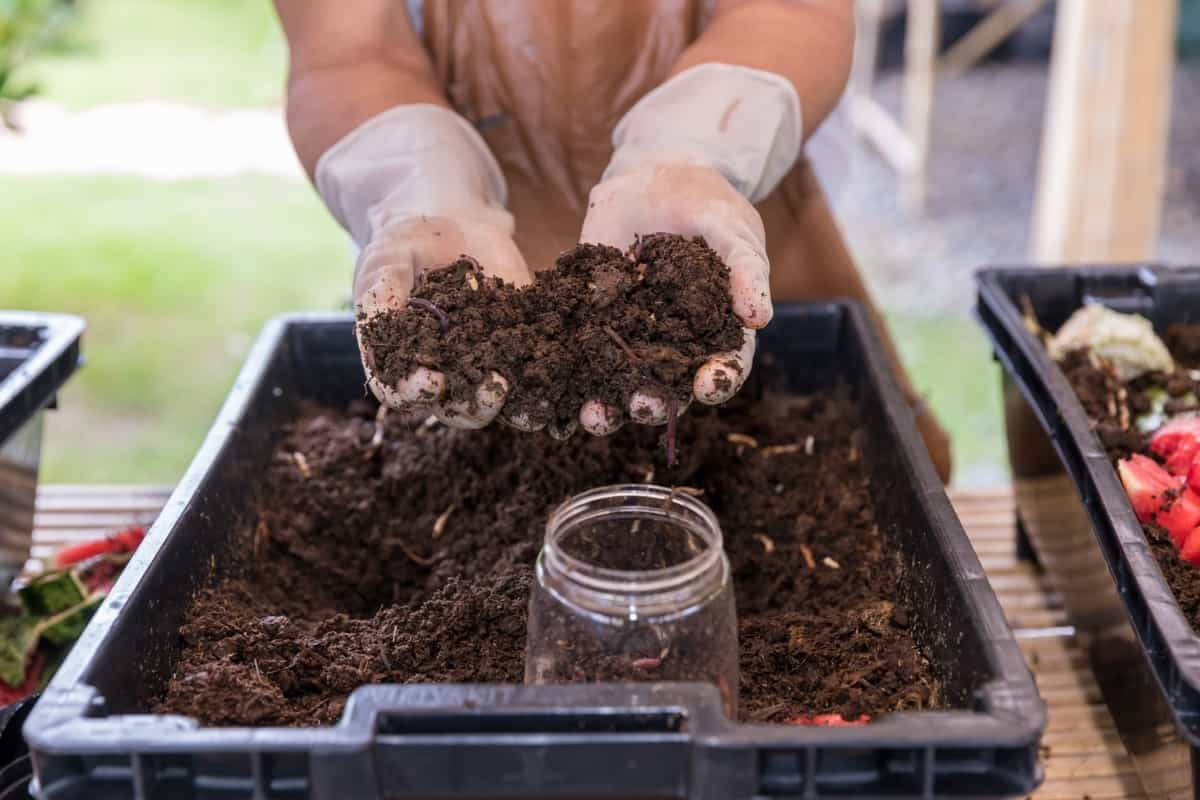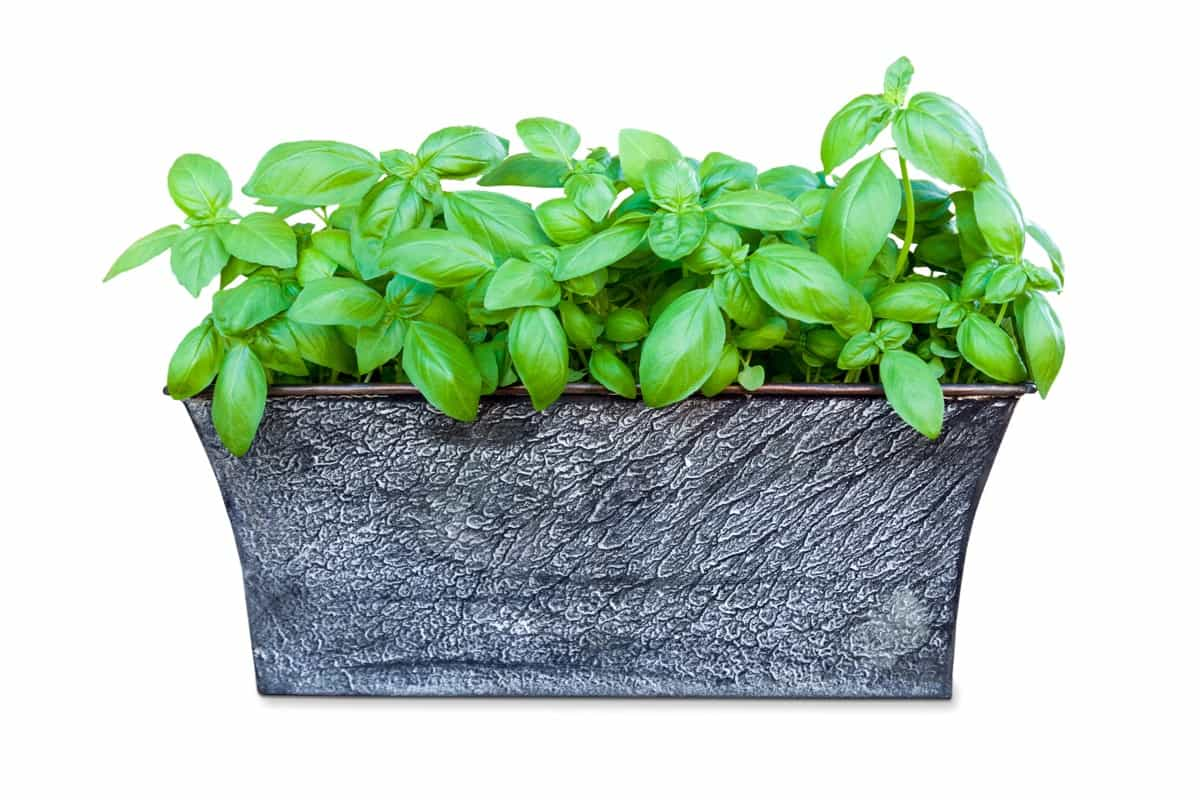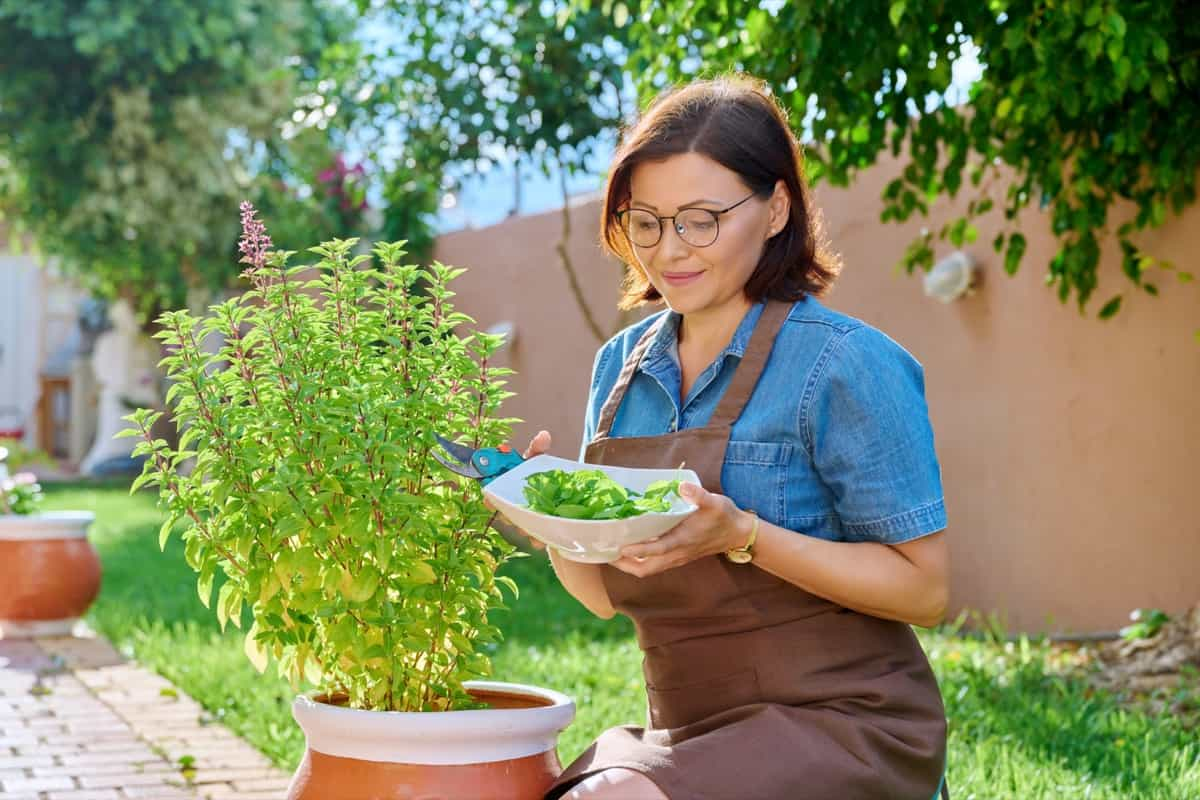Fertilizing potted basil is an essential aspect of maintaining healthy and thriving plants. Organic and natural fertilizers provide a sustainable and eco-friendly approach to nourishing your basil. We will explore here the benefits of using organic and natural fertilizers, discuss homemade options, understand the importance of the NPK ratio, and learn when and how to apply fertilizers to potted basil.

Organic Fertilizers For Potted Basil
These fertilizers are produced from natural sources and are free from synthetic chemicals. They offer numerous advantages, including enriching the soil with essential nutrients, improving soil structure, and promoting beneficial microbial activity. Some popular organic fertilizers for potted basil include vermicompost, worm castings, fish emulsion, and seaweed extract.
Vermicompost is rich in organic matter and provides many essential nutrients. Worm castings, also known as vermicompost, are the excretions of earthworms and are highly beneficial for the soil structure and nutrient content. Fish emulsion from fermented fish is a potent source of nitrogen, phosphorus, and potassium (NPK). Seaweed extract, derived from seaweed or kelp, is rich in trace elements and growth-promoting hormones.
Natural Fertilizers For Potted Basil
Natural fertilizers can significantly enhance the growth and health of potted basil plants. Wood ash is a popular choice, containing essential nutrients like nitrogen, phosphorus, and potassium. It helps promote vigorous growth and improves overall plant health. Another effective option is kelp meal, which is rich in trace minerals, vitamins, and growth hormones. It enhances the plant’s resistance to diseases and pests while improving nutrient uptake.
Lastly, bat guano is a potent organic fertilizer providing a balanced nutrient blend. It is particularly high in nitrogen and phosphorus, essential for promoting healthy foliage and strong root development. These natural fertilizers are excellent choices for nourishing potted basil plants and ensuring optimal growth and flavor.
Homemade Fertilizers For Potted Basil
Homemade fertilizers can be a cost-effective and natural way to nourish your potted basil plants. Banana peels are one of the great sources of potassium, promoting healthy root development and overall plant growth. Simply chop up a banana peel and bury it in the soil around the basil plant.
In case you missed it: Brown Basil Leaves: Possible Causes for Turning Brown, Remedies, and Treatment

Magnesium is abundant in Epsom salt and can help enhance the plant’s ability to absorb nutrients. Dissolve one tablespoon of Epsom salt in 4 liters of water and use it to water your basil plant once a month. Coffee grounds are another excellent fertilizer option, providing nitrogen, potassium, and other essential nutrients. Spread used coffee grounds around the plant base, being careful not to pile them too close to the stem.
NPK Ratio For Potted Basil
When fertilizing potted basil, understanding the NPK ratio is crucial. The NPK ratio represents the proportion of essential nutrients in a fertilizer, namely nitrogen (N), phosphorus (P), and potassium (K). These nutrients play a vital role in the growth and development of plants, including basil.
For potted basil, a balanced NPK ratio is generally recommended. A balanced ratio means the three nutrients are present in relatively equal amounts. The most commonly used balanced ratio for potted basil is 10-10-10. This means the fertilizer contains 10% nitrogen, 10% phosphorus, and 10% potassium.
When to Apply Fertilizer to Potted Basil
Knowing when to apply fertilizer to potted basil is essential for its optimal growth and productivity. It is generally recommended to start fertilizing basil after it has been planted for about three to four weeks. It allows the plant to develop its roots strongly and begin actively growing.
During the active growth, typically from spring to early fall, you can apply fertilizer every four to six weeks. It’s important to avoid over-fertilizing, as this can lead to nutrient imbalances and potentially harm the plant. Always follow the usage instructions on the fertilizer packaging for specific application rates.
How to Apply Fertilizer to Potted Basil
- Select a balanced fertilizer with a ratio of 10-10-10 or similar.
- Prepare the fertilizer as per the instructions on the packaging. This usually involves diluting the fertilizer in water.
- Water the basil plant thoroughly before applying the fertilizer. This helps prevent potential root burn from concentrated fertilizer.
- Pour the diluted fertilizer mixture evenly around the base of the plant. Avoid spreading the fertilizer on the leaves, which can cause leaf burn.
- After applying the fertilizer, water the plant again to ensure the nutrients are properly distributed into the soil.
Homemade Liquid Fertilizers for Potted Basil
One option is to create a compost tea by steeping compost in water for several days. This nutrient-rich mixture can then be diluted and applied to the soil. Another alternative is using seaweed extract, readily available at garden centers. This organic fertilizer contains essential micronutrients and can be diluted per the instructions on the packaging.
In case you missed it: Basil Companion Plants: What to Plant Next to Basil and What Not to Plant Next to Basil

Additionally, you can create a homemade fish emulsion fertilizer by blending fish scraps and water. This mixture can be strained and applied to the soil every few weeks for optimal growth. Utilizing these homemade liquid fertilizers ensures that your potted basil plants receive the necessary nutrients for healthy and thriving growth.
Importance of Organic Fertilizers for Potted Basil
Unlike synthetic fertilizers, organic fertilizers are derived from natural sources and are free from harmful chemicals. They provide essential nutrients to the plants, enhancing their overall health and vitality. Organic fertilizers improve soil structure, allowing better water retention and nutrient absorption.
Potted basil plants can achieve optimal growth, increased disease resistance, and higher yields using organic fertilizers. Moreover, organic fertilizers promote environmental sustainability by reducing water pollution and preserving soil quality. Therefore, incorporating organic fertilizers is of utmost importance for successfully cultivating potted basil.
Common Mistakes When Fertilizing Potted Basil
- Over-fertilizing: One of the most common mistakes is applying too much fertilizer. Excess nutrients can lead to leaf burn and root damage, ultimately harming the basil plant.
- Using the Wrong Fertilizer: Basil requires a balanced fertilizer with equal ratios of nitrogen, phosphorus, and potassium (NPK). Using a fertilizer high in nitrogen but low in other nutrients can result in excessive leaf growth and poor overall health.
- Applying Fertilizer too Often: Fertilizer should be applied at the recommended frequency, usually once every 4-6 weeks. Applying it too often can lead to nutrient imbalances and unhealthy growth.
- Neglecting to Water Before Fertilizing: It’s crucial to water the basil plant thoroughly before applying fertilizer. This makes the nutrients evenly distributed and prevents root burn.
- Fertilizing During Dormant Periods: Basil plants have dormant periods requiring less fertilizer. Fertilizing during these periods can disrupt their natural growth cycle.
In case you missed it: 6 Causes of Dying Basil Plants and How to Fix Them?

Conclusion
In conclusion, fertilizing potted basil is essential for its healthy growth and productivity. Organic and natural fertilizers and homemade alternatives provide a sustainable and eco-friendly approach to nourishing the plant. Understanding the NPK ratio, applying the fertilizer during the appropriate season, and following proper application techniques will help ensure your potted basil’s optimal health and flavor.
- Feed Your Flock for Less: Top 10 Tips to Save on Chicken Feed
- Ultimate Guide to Ossabaw Island Hog: Breeding, Raising, Diet, and Care
- Hatching Answers: The Top 10 Reasons Your Chickens Aren’t Laying Eggs
- Eggs and Economics: Breaking Down the Cost of Raising Backyard Chickens
- Defend Your Greens: Proven Methods to Keep Iguanas Out of Your Garden
- Ultimate Guide to Cinnamon Queen Chicken: A Comprehensive Guide for Beginners
- Ultimate Guide to California Tan Chicken: Breeding, Raising, Diet, Egg-Production and Care
- Ultimate Guide to Marsh Daisy Chicken: Breeding, Raising, Diet, and Care
- 10 Types of Chicken Farming Businesses You Can Start for Profits